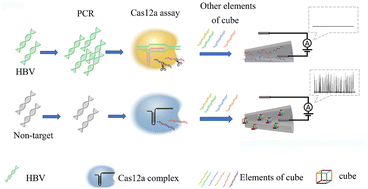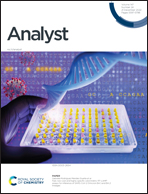A signal on–off strategy based on the digestion of DNA cubes assisted by the CRISPR–Cas12a system for ultrasensitive HBV detection in solid-state nanopores†
Abstract
Solid-state nanopores have been proven as a powerful platform for label-free single-molecule analysis. However, due to its relatively low resolution and selectivity, developing biosensors with good translocation signals faces two significant challenges: (1) small-sized chemical or biological targets show difficulty in producing recognizable translocation signals because of their weak interaction with the nanopore and (2) protein interferents that widely exist in biological samples or buffers would considerably deteriorate the noise level of the nanopore, submerging the translocation signal. Herein, we demonstrate an effective way to overcome both the challenges. DNA cubes were used as signal transducers that can achieve an ultra-high (>50 : 1) signal-to-noise ratio (SNR) translocation signal, which is maintained even in protein interferent-rich buffers. A sensing strategy was constructed via hepatitis B virus (HBV) target-triggered cleavage of the component elements of the DNA cube with the assistance of the CRISPR–Cas12a technology, which caused a great drop in the translocation rate. The elements to cleave were optimized, and the sensor performance was tested in different protein stabilizer-rich buffers and human serum. Coupling with the polymerase chain reaction (PCR) pre-amplification technology, HBV-positive or -negative classification was achieved with the detection limit reaching 5 aM. It is worth noting that in our method, all reaction buffers were directly used without further optimization, which is of great help for the practical application of solid-state nanopores.

- This article is part of the themed collection: Analyst HOT Articles 2022


 Please wait while we load your content...
Please wait while we load your content...